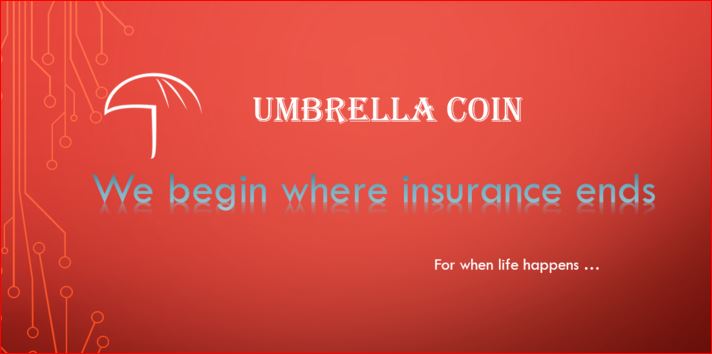Solutions based on Blockchain technology cover almost every area. An example of this is the insurance sector. Interesting proposals arise that seek to provide creative solutions to a complex of situations that in a conventional way have not found a better way to satisfy the needs of users. In this opportunity we will talk about Umbrella Coin, a proposal that promises to do much for the sake of insurance users.
With a decentralized vision in which there will be no intermediaries, Umbrella Coin ensures that it will protect you from being held hostage by the monopolies of insurance companies. There are no insurance agents and intermediaries with incentives to deny your claims. Simply exchange your ETH for the UMC tokens – the umbrella token – and use them to buy a policy. And the best part, if you do not end up using your premium, Umbrella returns you 100% at the end of the respective plan period.
As everyone knows, insurance policies are sold through an agent or broker and make commissions on your insurance sale. The cost of selling it is passed on to the policy holder. UMC solves this by allowing “policy holders” (or really, coin holders) to avoid buying overhead through agents and instead buy from other currency holders on the platform.

The insurance is sold based on the risk perceived by the insured. Actuaries are the people responsible for assessing the risk factors of an insured and determining a rate acceptable to the insured. Based on the perceived risk, or previous insurance claims, the insured can be seen with a greater responsibility and forced to pay more. Of course, in the event that you do not make a claim, your premium is a considerable benefit to the insurance agency with no monetary gain for the insured.
Most policies require holders to pay out-of-pocket when filing a claim, before the insurer agrees to cover any of the damages; this is what is known as deductible. Many insureds can not pay their deductible, forcing people to a payment plan or avoiding making a claim because of the cost. Lower premiums mean higher deductibles, which makes them less likely to use their insurance. The higher premiums mean lower deductibles.
UMC will operate with coin holders acting as policyholders and insurers, essentially combining the role of the traditional format. It is worth noting that UMC attempts to supplement insurance initially. UMC is a platform to ensure that after high insurance premiums, customers will not be left with high costs from their pockets. This will apply to all types of insurance, whether health, car, life, or property.
Some of the key features of UMC in terms of benefits for its users are:
- The maximum benefit a user is entitled to receive from his / her policy is 5 times the WBU spent within his / her policy period (365 days). Therefore, if you buy 2 ETH value of UMC during the crowdsale, you are entitled to 10 ETH value benefits for the year.
- At the end of the period, if no claims were made or the initial amount invested was not used, the user obtains his unused UMC.
- A user may decide to cancel his policy at any time even before the expiration date. However, they could do so with a 40% penalty to avoid depletion of funds.
Any currency holder can create a policy. The same will be linked to his/her portfolio address and a claim must be made against that policy. You can not file a claim against a policy not associated with your address. Claims must be initially judged by the community to be approved or rejected. Each claim will need supporting documentation to prove that it is a legitimate expense by the policy owner, and they are not making use of insurance reimbursement for their own benefit.
The community vote will take place for 24 hours, and the options will be:
a. Yes
b. No
c. Need more evidence
d. Fraudulent
In this way UMC ensures the decentralization of the assessment of the origin of a claim.
Umbrella’s crowfunding began on August 20, and will end on October 20, with an issue of 100,000,000 tokens. The reference value is 600 UMC = 1 ETH.
To learn more about the project, you can review their White paper where all the details are covered.




